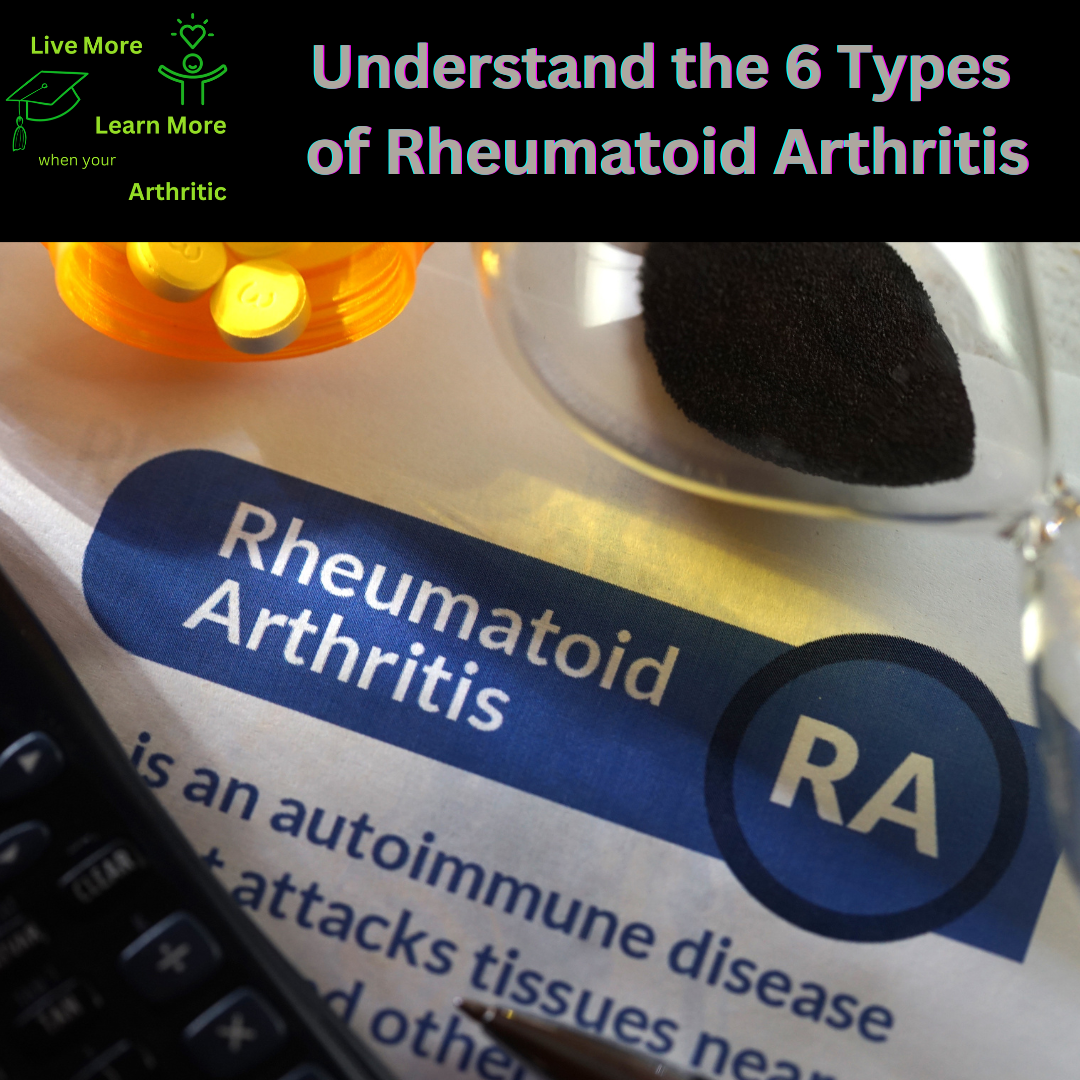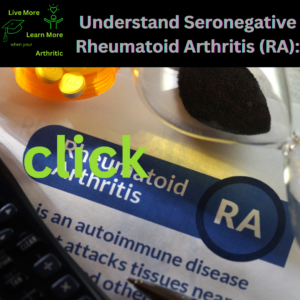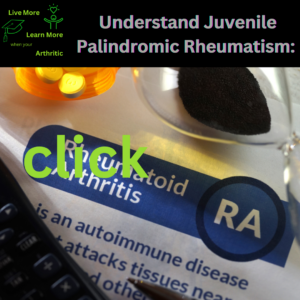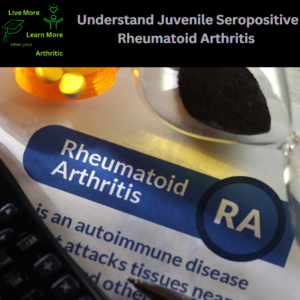
Understanding the 6 Subtypes of Rheumatoid Arthritis: Including a separate full report, Video, Description and more.
Here is a consolidated list of various types and related conditions within the spectrum of rheumatoid arthritis (RA), along with their characteristics and impacts:
Read each of the 6 Rheumatoid Arthritis Subtypes.
Seronegative Rheumatoid Arthritis (RA): 1 of 6 Subtypes of Rheumatoid Arthritis (RA)
Juvenile Rheumatoid Arthritis (JRA): 2 of 6 Subtypes of Rheumatoid Arthritis (RA)
Rheumatoid Vasculitis (JRV): 3 of 6 Subtypes of Rheumatoid Arthritis (RA)
Palindromic Rheumatism: 4 of 6 Subtypes of Rheumatoid Arthritis (RA)
Undifferentiated Connective Tissue Disease (UCTD): 5 of 6 Subtypes of Rheumatoid Arthritis (RA)
Seropositive Rheumatoid Arthritis: 6 of 6 Subtypes of Rheumatoid Arthritis (RA)
And the Rheumatoid Arthritis Severity Scale
.
- Seronegative Rheumatoid Arthritis (RA):

- Description: RA without detectable rheumatoid factor (RF) or anti-cyclic citrullinated peptide (anti-CCP) antibodies.
- Differences from OA: Autoimmune-driven inflammation affecting multiple joints.
- Similarities to OA: Joint pain, swelling, stiffness, but with different underlying mechanisms.
- Remission Likelihood: Variable remission rates; typically lower compared to seropositive RA.
- Autoimmune Comorbidities: Similar to seropositive RA.
- Age of First Onset: Varies but typically in adulthood.
- Impact on Health and Productivity: Mobility and daily activities can be affected.
- Life Expectancy with RA: Can be reduced with severe disease.
- Learn more about Seronegative Rheumatoid Arthritis (RA):..
..
- Juvenile Rheumatoid Arthritis (JRA):

- Description: RA diagnosed in individuals under 16 years old.
- Differences from OA: Early onset with potential for more severe joint damage.
- Similarities to OA: Joint pain, swelling, stiffness, but in younger patients.
- Remission Likelihood: Remission rates can vary; some may outgrow symptoms.
- Autoimmune Comorbidities: Increased risk of growth problems, eye inflammation.
- Age of First Onset: Childhood.
- Impact on Health and Productivity: Growth, development, and school activities.
- Life Expectancy with RA: Can be near-normal with effective treatment.
- Learn more about Juvenile Rheumatoid Arthritis (JRA):..
.
.
..
- Rheumatoid Vasculitis:

- Description: Inflammation of blood vessels associated with RA.
- Differences from OA: Involves vascular inflammation in addition to joint symptoms.
- Similarities to OA: Joint pain, swelling, and stiffness, but with vascular complications.
- Remission Likelihood: Generally lower remission rates due to systemic involvement.
- Autoimmune Comorbidities: Increased risk of organ damage (e.g., kidney, nerves).
- Age of First Onset: Usually older than typical RA.
- Impact on Health and Productivity: Organ function and skin integrity may be affected.
- Life Expectancy with RA: Can be reduced due to organ complications.
- Learn more about Rheumatoid Vasculitis:
.
- Palindromic Rheumatism:

- Description: Rare inflammatory arthritis with recurrent episodes of joint pain, swelling, and stiffness.
- Differences from OA: Episodes of acute inflammation followed by symptom-free intervals.
- Similarities to OA: Involvement of joints with pain and swelling.
- Remission Likelihood: Episodes may resolve spontaneously; can progress to chronic arthritis.
- Autoimmune Comorbidities: Progression to chronic arthritis or other autoimmune conditions.
- Age of First Onset: Adulthood.
- Impact on Health and Productivity: Episodes impact daily activities.
- Life Expectancy with RA: Can be near-normal with appropriate management.
- Learn more about Palindromic Rheumatism:.
..
- Undifferentiated Connective Tissue Disease (UCTD):

- Description: Condition with connective tissue disease symptoms but not meeting specific RA or lupus criteria.
- Differences from OA: Systemic involvement with joint symptoms; potential progression to defined autoimmune diseases.
- Similarities to OA: Joint pain, inflammation.
- Remission Likelihood: Variable; can evolve into defined autoimmune disease or remain stable.
- Autoimmune Comorbidities: Increased risk of developing lupus, rheumatoid arthritis.
- Age of First Onset: Adulthood.
- Impact on Health and Productivity: Multiple organ systems can be affected.
- Life Expectancy with RA: Can vary based on disease progression.
- Learn more about Undifferentiated Connective Tissue Disease (UCTD):.
- Seropositive Rheumatoid Arthritis (RA):

- Description: RA with detectable rheumatoid factor (RF) or anti-CCP antibodies.
- Differences from OA: Autoimmune-driven inflammation affecting multiple joints.
- Similarities to OA: Joint pain, swelling, and stiffness, but with different underlying mechanism.
- Remission Likelihood: Remission rates can vary; may respond well to targeted therapies.
- Autoimmune Comorbidities: Increased risk of cardiovascular disease, osteoporosis, interstitial lung disease.
- Age of First Onset: Usually around 40-60 years old.
- Impact on Health and Productivity: Mobility, daily activities, and productivity can be affected.
- Life Expectancy with RA: Can be reduced with severe disease and comorbidities.
- Learn more about Seropositive Rheumatoid Arthritis (RA)
- Additional Subtypes and Related Conditions:
- Felty’s Syndrome: Rare complication of longstanding RA with splenomegaly and neutropenia.
- Caplan’s Syndrome: RA with pulmonary nodules, often linked to occupational exposures.
- Still’s Disease (Systemic-Onset Juvenile Idiopathic Arthritis): Childhood arthritis with systemic symptoms.
.Rheumatoid Lung Disease: Pulmonary manifestations associated with RA.Rheumatoid Arthritis Severity Scale
Learn more about Rheumatoid Arthritis Severity Scale
 Conclusion: Rheumatoid arthritis (RA) encompasses a diverse spectrum of autoimmune conditions affecting joints and organs, each with unique characteristics and impacts on health, productivity, and life expectancy. Early diagnosis, effective management, and comprehensive care are essential for optimizing outcomes and improving quality of life in individuals with RA. Autoimmune comorbidities associated with RA can further impact overall health and longevity, underscoring the importance of holistic management and multidisciplinary care.
Conclusion: Rheumatoid arthritis (RA) encompasses a diverse spectrum of autoimmune conditions affecting joints and organs, each with unique characteristics and impacts on health, productivity, and life expectancy. Early diagnosis, effective management, and comprehensive care are essential for optimizing outcomes and improving quality of life in individuals with RA. Autoimmune comorbidities associated with RA can further impact overall health and longevity, underscoring the importance of holistic management and multidisciplinary care.
